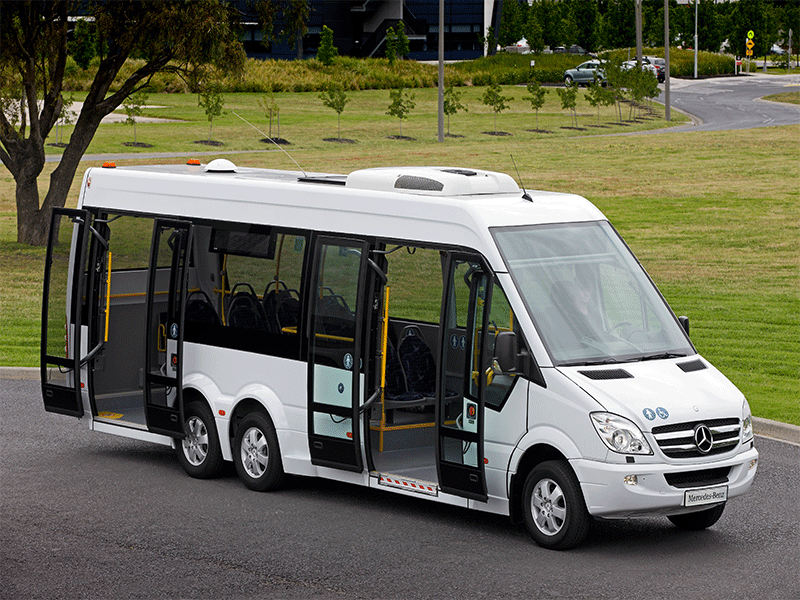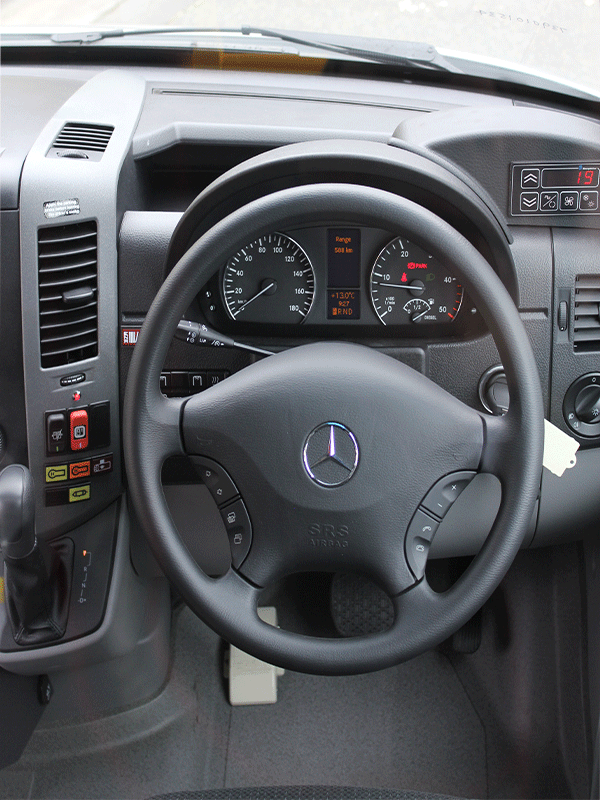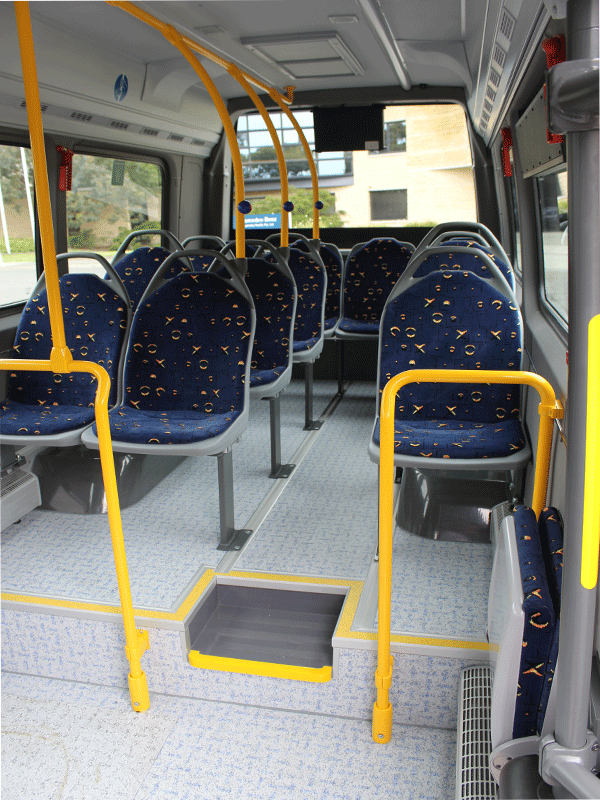The Mercedes-Benz City 45 is here, Steve Skinner takes the first one in Australia for a spin
At first it’s a hard concept to get your head around, especially if you’ve just stepped out of a highway coach: how can such a small engine pull so many passengers around?
The conundrum gets no easier when you start the engine up and move off — the motor sounds quite tinny. How is this 2-litre oiler going to haul up to 5 tonnes of metal and passengers?
Then when you put the boot in, you see that the older 6-speed auto box in this unit changes gears at up to 4,000rpm, not far off the redline at 4,200rpm.
At a speed-limited 95km/h on the freeway, it’s doing 3,800rpm. So presumably it would be nearly red-lining at 100km/h.
But at least the little engine does respond when you speed up to change lanes on the arterials, and merge onto the freeway. It clearly has more power and torque than it sounds. The new 7-speed auto box will presumably change up earlier. A rev limiter stops the engine harming itself.
We’re talking about the new Mercedes-Benz Sprinter City 45 mini-bus, which is so new this is the first one in the country. ABC went for a drive near the Mercedes-Benz Australian HQ at Mulgrave in south east Melbourne, the day after being hosted to the Sprinter buses official launch on the banks of the Yarra.
This is also the first new Mercedes-Benz product launched in Australia for many years.
CITY SPRINTER BUS
The City 45 is based on the Sprinter van, and has the same 2.1-litre engine with a standard 95kW (130hp) of power and 305Nm of torque at 1,200-2,400rpm. That’s not a lot for about 16 seated passengers and up to another dozen standing.
But if this smaller horsepower bi-turbo is too peaky for your liking, you can pay extra for the same displacement pushing out a bigger 120kW (163hp) and 360Nm at 1,400-2,400rpm.
Either way, Mercedes stresses that as the name implies, this vehicle is for stop-start urban applications, with the average speed in Australia’s capital cities these days down to about 35km/h. It’s not meant to be a highway cruiser.
What you might lose in grunt, Mercedes says you gain in cost-efficiency. The company says this little bus returns the same fuel economy as a car — and we’re talking about a 4 cylinder Toyota Camry here, not a V8 Landcruiser.
So if you’re using the City 45 in suburbia or in a regional centre as a late-night city route bus carrying just a few passengers, you will clearly save a lot of fuel compared with a near-empty conventional bus taring 10 tonnes or more.
The initial investment will set you back between about $135,000 and $170,000 depending on your specifications, which is of course much less than a full-size bus.
Throw in a service interval up to 60,000km — depending on what the ‘Assyst’ maintenance computer system recommends — and Mercedes expects to sell shiploads of these versatile units.
With the rapid ageing of the population, other expected applications include short-term transfers from RSL clubs, retirement villages and so on.
“Mini-buses are critical to the Mercedes-Benz organisation,” General Manager for the Mercedes-Benz Bus and Coach Group in Australia ,Justin Whitford says.
“They’re opening up new market segments to us that were previously not in the Australian and New Zealand business.”
SAFETY FIRST
A major selling point for the City 45 will be Mercedes-Benz’s excellent reputation for safety technology.
“It’s obviously a product that’s very oriented around safety,” Whitford says.
“There’s a range of safety features that you’re used to hearing about in Mercedes-Benz passenger cars that we will have in the mini-bus program.”
That range includes ABS and adaptive stability control as standard.
We can vouch for the braking ability. The brake pedal had felt a little spongy until I hit it very hard with no traffic behind me. The mini-bus stopped extremely well.
Not wanting to try out stability control on busy Melbourne roads, we will rely on ABC colleague Matt Wood’s recent experience in a pair of Sprinter vans on the Mount Cotton test track near Brisbane.
“Out on the skid pan a fine layer of both water and diesel awaited,” writes Matt. “One Sprinter van had its ESP [Electronic Stability Program] systems disconnected, the other cab chassis Sprinter had them all functioning.
“I found myself reliving dreams of speedway glory as I circulated the skid pan sideways, with only a couple of spin-outs. But to then jump into the Sprinter with functioning ESP and try the same antics was a real eye opener.
“I just could not get the empty cab chassis to hang its tail out.”
Part of the stability control is cross wind assist, which kicks in at more than 80km/h. As Matt describes it: “If the vehicle swerves or rocks without any steering input from the driver the system will apply braking force on the side of the vehicle that needs it to remain stable.”
Then there is the collision prevention assist function which comes into play at speeds of over 30km/h and has a maximum range of 65m.
“The system gives the driver a visual warning on the dashboard, then sounds an audio warning and then primes the brakes for a hard stop,” says Matt. “It doesn’t however, intervene and hit the brakes; the driver still has to do that.”
Other safety features include blind spot assist, lane keeping assist and even high-beam assist which will dip the lights for you.
Not to mention ASR – Acceleration Slip Regulation.
PLEASE TAKE YOUR SEAT
Ironically despite all this safety wizardry, the City 45 evaluation bus driven by ABC lacked that most basic piece of safety technology — seat belts.
However, Mercedes assures us that these will be installed by the time the buses hit the road in Australia.
The company says the buses will typically arrive from Germany with the seating already installed, but there will be the option of having locally-manufactured seats.
The unit we drove had 17 seats when you include the four sideways-facing seats that can fold up or down to accommodate either more standees or two wheelchairs.
The 13 fixed seats were basic city route bus units, with very little legroom on the four of them over the rear wheel hump. Big passengers would have to sit up the front or at the sides near the outward swinging door.
There was an easily-moved ramp for easy access from the pavement to the low floor, and there will be the option of a mechanical ramp with lifting ability in vehicles specified for transporting disabled people.
I was a little surprised to see that there is no air seat option for the driver, but the standard seat was comfortable enough for the relatively short time I was behind the wheel.
My ABC colleague passengers — editor David Goeldner and videographer Andrew Britten — didn’t complain about the ride up the back on the air bag suspension, and we all agreed the bus was remarkably quiet, especially considering the peaky engine.
Mercedes describes the low-floor City 45 as “ground-breaking” and that was almost what happened when we ventured into the grounds of Monash University for a photo shoot.
The exhaust scraped on a steepish speed hump. However, Mercedes assures us that won’t happen by the time the model is fully evaluated and modified for Australian roads.
Nevertheless the driver can raise or lower the suspension by 5cm.
As you would also expect for a city bus, the city 45’s turning circle and manoeuvrability are good.
SPRINTER SIBLINGS
What does the number 45 mean in the City mini-bus name?
The ‘4’ refers to a wheelbase code – not the 4.3m in actual wheelbase length that you might expect. The ‘5’ is a bit more intuitive as it refers to the GVM (gross vehicle mass), which is 5 tonnes.
The City 77 has a 7-tonne GVM, because it has dual rear axles, which looks unusual on a mini-bus. Mercedes is evaluating a left-hand drive City 77 in Australia at present.
Then there is the City 35 and 65. Adding another dimension to the Sprinter bus range in Europe is varying sizes in the ‘Travel’ (long distance and VIP), ‘Transfer’ (inter-urban and school/charter) and ‘Mobility’ (all-rounder) variants.
Mercedes says that in addition to the City 45 and a shorter 35, a Transfer 45 will be released in Australia next year. This does not have a low-floor, and will seat about 19 passengers, with none standing. There will also be a luxury variant of this model — a mini-coach with reclining seats, curtains and so on.
One last minor point: there are no cup holders for the driver. The Sprinter van has two, but in the bus we drove these were covered by the air conditioning control unit and the destination board unit.
PLUSES
Great electronic braking and adaptive stability features
Will run on the smell of an oily rag
Long service intervals
MINUSES
High-revving on the freeway
Trial version doesn’t like speed humps
Big passengers won’t fit in several of the seats
SPECS
MAKE/MODEL: Mercedes-Benz Sprinter City 45 mini-bus
ENGINE: 4 cylinder 2.1-litre turbo diesel, Euro 6 emissions
POWER: 95kW (130hp) and 120kW (163hp)
TORQUE: 305Nm and 360Nm
TRANSMISSION: 7-speed fully automatic
DIMENSIONS: 7m long, 2m wide, 2.8m high
CAPACITY: Almost 30 people (about 16 seated, 12 standing)
PRICE: From $135,000




